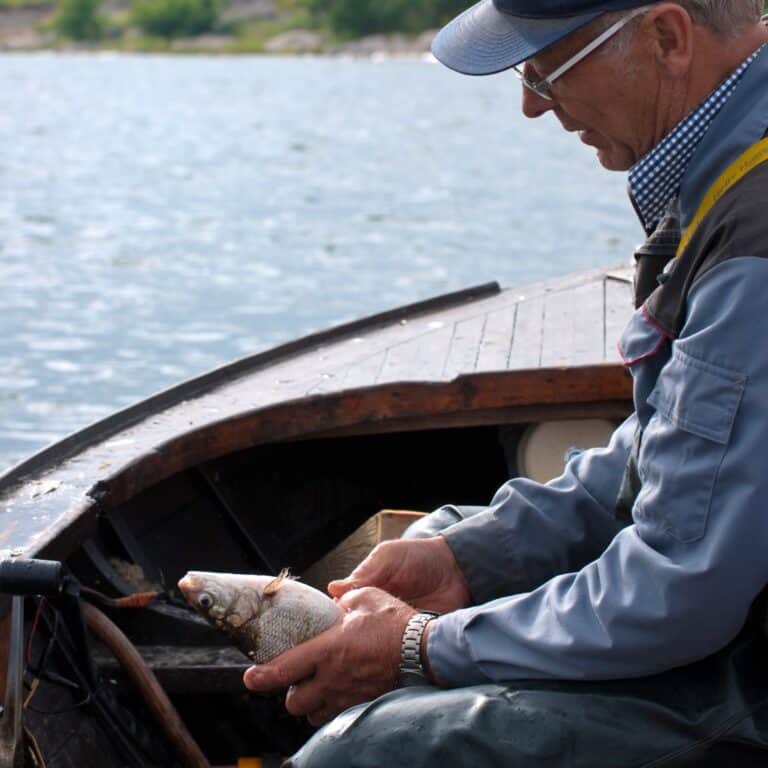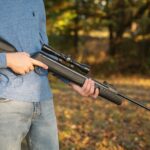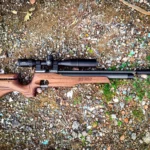It could be argued that Ohio’s so-called “Hole-In-The-Horn Buck” is the most famous whitetail in the world. In fact, this legendary deer, with his incredible rack and story to match, might well be the most famous big game animal ever to come from the North American continent!
My own involvement in this story began sometime around 1977 when I was in the business of outfitting guided hunts, primarily for trophy whitetails. As a group of hunters and I sat around a campfire one evening, one of the clients pulled out photos of two of the largest bucks I’d ever seen. Supposedly, a “friend” of his had killed both animals, but my client couldn’t offer any other details. Although those bucks remained firmly implanted in my mind, further details continued to be unavailable for the next few years.
Then, in the early 1980s, I was fortunate to meet Fred Goodwin of Sherman Mills, Maine, one of America’s foremost whitetail collectors. Fred had gathered more than 1,300 sets of antlers over a span of nearly 70 years, and along with these, he’d acquired thousands of antler photos. As dug through cigar and shoe boxes full of photos, one in particular caught my eye — a photo just like one of those I’d seen four years earlier around that campfire!
The inscription on the back of the photo, which was in Fred’s handwriting, read, “giant non-typical found dead along railroad tracks, greatest spread 36 inches, 60 points, Kent, Ohio.” I soon learned that Fred had acquired the photo several years earlier from one of his many pen pals. Fred had never seen the buck, but he claimed it was the largest non-typical whitetail he knew of.
Eventually, I learned that the photo had come from a private hunting club in Kent, Ohio, and that the buck still hung in the bar there. In the summer of 1982, I talked with a couple of club members to learn more of this deer. Because of time and distance from my Montana home, however, it was actually August 1983 before I could travel to Kent to see the giant for myself.
By then, he’d hung in the smoke-filled bar for right at 40 years, and both the mount and antlers were nearly black from stains and dust. But, I immediately knew the antlers were of gigantic proportions and that they were even larger than they’d appeared in the photo. My initial rough score was off the “Richter Scale,” at 349 2/8 Boone and Crockett points well above that of the recently discovered 333 7/8-point world record from Missouri!
At the time of my visit, widespread interest in collecting whitetail racks was just beginning. I’d already acquired a substantial collection of outstanding bucks (many of which are featured in this book) and had begun displaying them at sportsmen’s shows. The Kent Canadian Club was interested in making its giant buck more visible to the general public, and I eventually acquired the mounted head.
North American WHITETAIL magazine, which I had been involved with since I helped in its founding in 1982, also played an instrumental role in this saga. We shared a common goal of uncovering the origin and history of the buck and passing along that information to the hunting public. As I dug into the deer’s background, learned that he’d been found dead more than 40 years earlier and had hung in virtual seclusion ever since.
The Kent Canadian Club was founded in the early 1920s by a group of local hunters and fishermen who shared a special sporting interest in Ontario, Canada, and fellowship at their local clubhouse/bar in Kent. In the early days of the club, land was purchased at a site along the French River, where it joins Elephant Lake in Ontario. Later, a main lodge and cabins, bath houses, etc., were added, and it became the focal point of recreation for the membership.
Because most of the membership lived near Kent, a clubhouse/bar was also established there. The club’s 300 social members can use the local facility, but only the 20 “backroom” members are allowed to use the Ontario site.
One of the early members, Charlie Flowers, was an engineer for Erie Railroad Company of Ohio and apparently was directly responsible for the club’s ownership of the rack. It’s unclear whether Charlie was one of the individuals who found the deer or if he merely came into possession of the antlers from another person. Regardless, he ended up with the rack.
At the time I acquired the Hole-In-The-Horn, the circumstances surrounding the buck’s death and recovery were largely speculative. According to descendants of those involved and other information available then, the buck had been found dead along the railroad right-of-way near Windham, Ohio, in 1940 or shortly thereafter. The carcass was badly decomposed, so only the head was salvaged. It was believed that one of the engineers spotted the dead buck from the train itself and at some point (then, or at a later date) recovered the antlers.
According to what I could learn at the time of my investigation, the buck had been found in or near the Ravenna Arsenal in Portage County. This arsenal is still used for storage of military munitions, and for security reasons, it’s surrounded by a high fence. What nobody could tell me was whether or not the fence had played some role in the deer’s death. Had the barrier caused him to become trapped, resulting in death by collision with the train? Or, had he perhaps become entangled in the fence itself and died from injuries, stress or starvation? And for that matter, on which side of the fence was he found? Apparently, nobody knew.
I was told that Charlie had sold the rack to the Kent Canadian Club for $25. The club then commissioned Ben Morgan, a taxidermist in nearby Akron, to acquire a new cape and mount the head. Once completed, it hung in the club’s bar and essentially remained anonymous until I “discovered” it. But, this was not just any deer hanging in a bar he would have been the undisputed world record for 40 years!
Once the head arrived at my home, there was time for closer scrutiny and opportunity for more careful measuring. There was no doubt that the head would become either No. 1 or No. 2 in the B&C record book. The staff at North American WHITETAIL and I knew this buck was a world record contender, so we searched for a name that would give him his own identity. Because there was no hunter’s name to attach to this deer, as there is with most other trophy heads, we had to find something else to call him.
At that time, perhaps the most mysterious aspect of this rack was the fact that one of the large drop tines on the right main beam had a small hole through it. There was a great deal of speculation as to how and when the hole was created, so we dubbed this awesome animal the “Hole-InThe-Horn Buck.” That moniker has since become universally accepted.
From the first time I unofficially scored the head, I knew it was a measurer’s nightmare, as it
had configurations of antler never before encountered on any whitetail rack. There was obviously more than one interpretation of how it should be scored, but most of the net scores from my measurements and those of many experienced measurers fell somewhere in the 340s—usually between 342 and 349 points.
Based on these unofficial scores, we felt the probability was high that this buck’s final score would exceed the 333 7/8-point score of the world record “St. Louis Buck,” which had been found dead less than two years earlier. But, we also knew the margin was close enough that the official scoring for entry into the records should not be done by just any official measurer. We wanted it done by someone who was very experienced and well respected within B&C’s ranks. No measurer fit this description better than Phil Wright, chairman of the Scoring Committee and one of the most senior members of the club.
On August 27, 1983, the head was taken to Phil for the official scoring. After long and careful examination, he arrived at an entry score of 342 3/8, well above the world record. Phil also stated at the time that two or three other abnormal points he hadn’t included in the total possibly could be added in during a final scoring by B&C judges’ panel. If these points were included, the final score would be close to 349 points, very near my initial net score.
Based upon Phil’s official entry score, the December 1983 issue North American WHITETAIL announced the shocking news of this historic buck and published information on both his “discovery” and the recent scoring. The magazine called the buck a “new world record,” because according to Phil’s official entry score, he was indeed just that.
Just a year prior to the initial scoring of the Hole-In-The-Horn, the enormous buck found dead near St. Louis had been officially scored by B&C measurer Dean Murphy, who also worked for the Missouri Department of Conservation and was an official member of the Awards Program judges’ panel. Based upon Dean’s entry score of 325 3/8 points, the Missouri buck had been highly publicized by newspapers and sporting magazines (including North American WHITETAIL) as a “new world record.”
When the St. Louis Buck had first been announced to the world, he wasn’t yet an “official” world record, because he hadn’t been verified as such by a panel of B&C measurers. He was to be remeasured in the spring of 1983, at which time a final decision on his score would be rendered. However, to my knowledge, there was no negative reaction to claiming this deer to be/the next No.1 non-typical.
The announcement of the Hole-InThe-Horn Buck in North American WHITETAIL followed that precedent. According to an official score sheet filled out by Phil Wright, the Ohio buck was just as much a “new world record” as the Missouri buck had been the previous year, when all anyone had to go on was Dean’s entry score.
Only a couple of months prior to my acquiring the Hole-In-The-Horn Buck, in the summer of 1983, B&C’s 18th Awards Program was held. There, the official score of the Missouri buck was raised from 325 3/8 points to 333 7/8. At the time, this hardly seemed an issue, because either way, the score was far in excess of Jeff Benson’s 286-point world record from Texas. But now, there was a new contender for that crown.
The next three-year scoring period culminated with the 19th Awards Program on June 28, 1986. Top recent entries in all big game categories were to be on hand for panel scoring and display. It was pointed out by B&C officials that should the Hole-In-The-Horn not appear, he’d be listed in the next record book with an asterisk, indicating that the score shown was still subject to verification by a judges’ panel. What’s more, we were told that the deer could be dropped from the record book at some point in the future if not panel-measured. Eager to have the score confirmed, I placed the Hole-In-The-Horn in the custody of Phil Wright for transportation to the Awards Program.
When the buck was remeasured by the panel, the original 5×5 typical frame was rejected and a 4×4 typical configuration chosen. The final score submitted by the panel was 328 2/8 points, and it wasn’t subject to appeal. To everybody’s surprise, the Hole-In-The-Horn had become the official No. 2 non-typical.
From the first announcement of the original entry score of this buck, there was in certain quarters criticism of claims that he was a new world record. This seemed strange to me at the time, and still does, because the first wave of publicity on the Hole-In-The-Horn was little different from that regarding the Missouri buck. When these deer were revealed to the public, neither was an “official” world record; however, each had been entered at a score that, if upheld, would make him one.
Whatever the motivations for downplaying the Ohio buck, the resulting confusion about which buck was actually “bigger” detracted from the fact that these two racks tower above all others as the largest of all time. Both the Hole-In-The-Horn and the St. Louis Buck are of a size that could hardly even have been imagined before they surfaced. Since the B&C record book had been founded, the Benson Buck from Texas had been the undisputed No. 1 non-typical. Then, out of the clear blue, within a couple of years of each other, two bucks that exceeded even the most optimistic dreams of the whitetail fraternity had come onto the scene. A new benchmark had been established.
Regardless of his final score, the Hole-In-The-Horn Buck is undeniably one of the two most awesome non-typicals of all time. Even though he looks huge in photos, they still don’t reflect his true size. For example, photography can’t indicate that even after 40 years of drying, the rack still weighs 11 1/2 pounds!
It’s also worth noting that while phenomenal mass is what makes the Hole-In-The-Horn so impressive in the eyes of many experts, it actually contributes little to his final score. I think most whitetail aficionados who’ve seen both heads would concede that the Hole-In-The-Horn has more antler volume than any other buck in history, including the St. Louis Buck. On the other hand, the St. Louis non-typical has a lot of long points, and he apparently grew several more that broke off before he was found. So, the debate over which of these bucks is bigger undoubtedly will continue.
However, as of very recently, we’re no longer in the dark as to what caused the unique antler feature that gave the Hole-In-The-Horn Buck his name. As noted, at the time I conducted my interviews and other research on the story of this buck (1983), about all that was known for
certain was that a railroad man named Charlie Flowers had sold the antlers to the Kent Canadian Club and that taxidermist Ben Morgan had mounted the deer. After that story appeared in the
December 1983 issue of North American WHITETAIL, we naturally hoped somebody out there might come forth with new information, but more than a decade passed without that happening.
Then, in 1995, WHITETAIL editor Gordon Whittington received a cryptic note with a Florida postmark. “For information on the Hole in Horn buck, contact me,” it read. “I was present.”
Well aware that all eyewitnesses to the recovery of this deer had supposedly been dead for many years, Gordon was understandably skeptical. But, he dialed the phone number on the card anyway, and in so doing, he took the first step toward solving the greatest mystery in whitetail history.
As it turned out, the person who’d sent the card—a 76-year-old gentleman named George Winters—had indeed seen the Hole-In-The-Horn Buck in the flesh. -What’s more, he’d apparently been the first human to touch that enormous right antler with the strange hole through it. And in so doing, he told Gordon that he’d seen with his own eyes what had caused the hole!
George recounted that back in the early 1940s, when he was in his early 20s, he worked on a maintenance crew inside the arsenal. One bitterly cold morning, he and another guy were riding along a road near the perimeter fence when they saw several railroad workers on the outside of the fence. The men had apparently come down from the railroad track, which was roughly 75 yards from the fence.
Eager to see what was going on, George and his companion parked and walked down to the fence. There, they found the railroad workers pulling on the body of a large animal, which was stuck under the barrier. Actually, the carcass was entirely outside of the fence but part of the rack was wedged beneath the wires.
“We didn’t know what it was,” George remembered. “One of the men said, ‘It’s an elk!’ Then, another one said, `No, it’s a moose!’ I’d seen deer before, but really wasn’t sure if this was one or not. The animal had been dead for a week or so, from the looks of it, and he was huge. He looked like he weighed 300 or 400 pounds. He’d obviously been hit by a train.”
One of the railroad men—George never caught his name —announced that he wanted the antlers, and the crew started pulling the giant out from under the fence. But, the animal wouldn’t come free. George noticed that when they pulled on the legs, the fence swayed. The rack itself was stuck.
George got a shovel and began working to free the right antler, which was solidly wedged under the wires. “It had been so cold that the ground was frozen down six or eight inches,” George recalled. “That antler was actually frozen into the ground. The fence was made of chain link, and it had stiff wires sticking down along the bottom of it. When I finally got the rack free, I noticed one of those pieces of wire was sticking down through the antler!
“I guess for years everyone has been wondering what made that hole,” George noted, “but it definitely was caused by that wire.”
This all makes sense to me. There are several scratches around the hole, and its diameter is roughly the same as that of the wire used on chain-link fences. Because this drop tine is rather “porous” out near its tip, I have no trouble believing that a buck thrashing around in pain would be able to poke a stiff wire all the way through it.
So, there you have it—an unexpected eyewitness account of the recovery of what might well be the most legendary whitetail of all. Now, it seems, the book on this giant can be closed once and for all.
CLICK HERE TO SEE ANOTHER HUNTER’S CLAIMS AS TO WHY THERE IS A HOLE




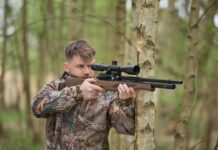






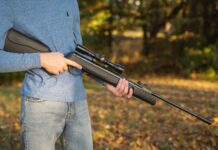







































 A number of different shrubs will work well for this project. Some good ones to consider are: native American honeysuckle bushes, dogwood shrubs (graystem, silky, or red osier), lespedeza, crab apple, Chickasaw plum, chinquapin, viburnum and indigo bush. They’ll not only create security cover, deer will nibble on most of these plants, adding to the travel corridor’s attraction.
A number of different shrubs will work well for this project. Some good ones to consider are: native American honeysuckle bushes, dogwood shrubs (graystem, silky, or red osier), lespedeza, crab apple, Chickasaw plum, chinquapin, viburnum and indigo bush. They’ll not only create security cover, deer will nibble on most of these plants, adding to the travel corridor’s attraction. 7. Build big buck bedding cover. Mature deer might walk through your land or venture onto it looking for does as the rut swings in. They might visit food plots you’ve created for a bite to eat, but you’ll never have old bucks stay on your land without good bedding cover.
7. Build big buck bedding cover. Mature deer might walk through your land or venture onto it looking for does as the rut swings in. They might visit food plots you’ve created for a bite to eat, but you’ll never have old bucks stay on your land without good bedding cover.







